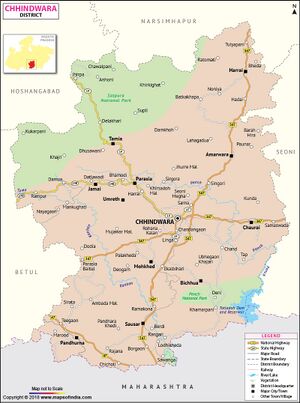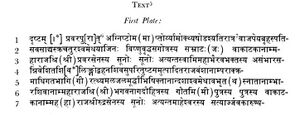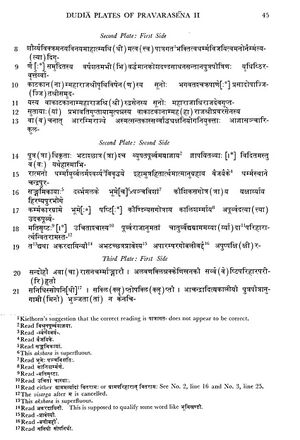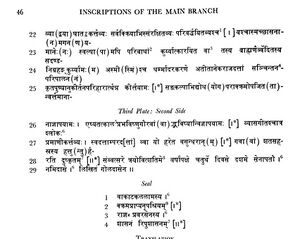Dudia Chhindwara
| Author:Laxman Burdak, IFS (R) |

Dudia (डुडिया) is a village in ..... tahsil in Chhindwara district of Madhya Pradesh.
Variants
Location
Jat Gotras Namesake
Dudia Plates of 23rd year of Pravarasena II
These plates were in the possession of some Gonds at Dudia in the Aser pargana of the Chhindwara District of Madhya Pradesh. They have been edited before, with facsimiles, by Dr. Kielhorn in the Epigraphia Indica, Vol III, pp. 258. They are edited here from the same facsimiles.
The copper-plates are four in number, each of which measures 7-1/2" long by 3-5/8" broad. The second and third plates are inscribed on both sides, the first plate is so on one side, and the fourth is blank and merely serves to protect the writing on the second side of the third plate. The plates are quite smooth, their edges having been neither fashioned thicker nor raised into rims; but the writing, nevertheless, is in an excellent state of preservation.....The weight of the four plates is 3-1/4 lbs. ; that of the ring, the copper band and the seal is 1/2 lb.; total, 3-3/4 Ibs1.... The characters belong to the box-headed variety of the southern alphabets and resemble those of the preceding Indore plates. Like the latter, they show two forms of n and b : the curve of l encircles the letter on the left as in -lalāmasya in line 1 of the seal; the sign of the jihvāmūliya occurs in line 22 and that of the upadhmānīya in line 3 of the seal and line 16 of the plates. Inter-punctuation is shown by one or more horizontal or vertical strokes. The Language is Sanskrit, and, with the exception of the legend on the seal and one imprecatory verse in line 27-28, the whole record is in prose. As regards orthography, we find that a consonant has been reduplicated before and after r as in parākkram- , lines 4-5 and -Aptoryyām-, line 1; before as in Bhagiratthy-amala, line 5; and after anusvāra in samvvatsare, line 28.
The inscription, which opens with drishtam, is one of the Vakataka Maharaja Pravarasena II. His genealogy is given here exactly as in the Jamb plates, his maternal grandfather being called Devagupta. The object of it is to record the grant, by Pravarasena, of 25 (nivartanas) of land at Darbhamalaka (दर्भमलक) in the Chandrapura Sangamika (चंद्रपुर संगमिक), to one Yakshārya of the Kausika gotra, and of sixty (nivartanas) of land2 at the village of Karmakara (कर्मकार) in the Hiranyapura-bhoga (हिरण्यपुर-भोग) to one Kaliśarman of the Kaundinya gotra. The order is addressed to the royal officers, soldiers and policemen in the Arammi-rajya (आरम्मी राज्य) in which evidently both the aforementioned villages were situated. The charter was written by Goladasa while Namidasa was the Senapati. It was issued from Pravarapura.
1 Ep. Ind,, Vol. III, pp. 258-59.
2 The figures of land (bhumi) given here, like those in the Chammak plates, probably refer to the nivartanas. See line 22 of the Pattan plates (No. 13, below) which mention 400 nivartanas of land according to the royal measure.
[p.44]: The record is dated, in line 28, on the tenth day of the fourth fortnight of the rainy season in the twenty-third year evidently of Pravarasena IIs reign. It does not admit of verification, but probably corresponds to the tenth tithi of the bright half of the month Bhadrapada. The date is noteworthy as it is one of the two season dates known so far from Vakataka inscriptions. In all other inscriptions dates are recorded in lunar months and tithis.
The localities mentioned in the present grant have not yet been satisfactorily identified. Dr. Kielhorn suggested the identification of Chandrapura with Chandpur, 'which lies to the south of Siwani and to the west of the Wenganga riveri’1, but he could not locate the other places mentioned in the grant. Dr. Hiralal proposed to identify Arammi with Arvi, the chief town of the Arvi tahsil of the Wardha District, and Chandrapura with Chandur where there is a confluence of the two rivers Chandrabhaga and Sarasvati. Further, he suggested that Hiranyapura might be Sonegaon near Chandur and Karmakara, Kalamgaon close to the same town2.
These identifications also are not quite satisfactory. A clue to location of the places is possibly afforded by the mention of Hiranyapura (हिरण्यपुर). This town may have been situated on the river Hiranya which is mentioned in the Wadgaon plates of Pravarasena II. As shown elsewhere, this Hiranya (हिरण्या) is identical with the modern river Erai3. Chandrapura may be the modern Chanda, the chief town of the Chanda District. This old name of the town is still current. Near Chanda there is the confluence of the two rivers, Erai and Jharpat. In fact the town of Chanda is situated in the angle formed by these two rivers, so that its situation answers to the description of Chandrapura in the present grant viz. that it was a sangamika or ‘a tract of land near the confluence of two rivers’ ; but the mention of Arammi-rajya in the recently discovered Pandhurna plates4 also has raised doubts about these identifications. Since both the grants which mention Arammi-rajya come from the Chhindwara District, we must evidently look for the places situated in them in that very district. As shown elsewhere, some of the localities referred to in the Pandhurna plates can be identified in the neighbourhood of Pandhurna, which indicates that Arammi, the headquarters of that division, may be modern Amla, about 40 miles north by west of Pandhurna. None of the places mentioned in the present grant can, however, be traced in that region, unless Hiranyapura is Harankhedi, about 6 miles north of Multai.
1 Ep Ind., Vol. III, p. 260.
2 I.C.P.B., p. 93.
3 Below, p. 54.
4 No. 14, lines 26 and 29.
5 From the facsimiles facing pages 260 and 261 in Ep. Ind, Vol. III.
6 Here and in many places below, the rules of sandhi have not been observed.
7 Originally निरोत्र, changed to निरात्र.



[p.46]: Seen. From Pravarapura —
By the order of the illustrious Pravarasena (II), the Maharaja of the Vakatakas, born of Prabhavatigupta, the daughter of the Maharajadhiraja, the illustrious Devagupta, who is the son of the illustrious Rudrasena (II), the Maharaja of the Vakatakas—
(Line 13). Our officers of noble birth, who are employed by the order of the Sarvādhyaksha (General Superintendent) [and) who exercise their authority by (Our) command and (Our) soldiers and policemen in the Arammi-rajya should be directed by the following command which is well known (to them ) : —
“Be It known to you that in order to increase Our religious merit, life, power and prosperity and to obtain blessings for ourself, we have donated here at Our place of religious worship with the pouring out of water twenty-five nivartanas of land in (the village of)
[p.47]: Darbhamalaka (दर्भमलक) in the Sangamika of Chandrapura (चंद्रपुर संगमिक) to Yakshārya of the Kaushika gotra, and sixty nivartanas of land in the village of Karmakara (कर्मकार) situated in the bhoga of Hiranyapura ((हिरण्यपुर)) to Kalisarman of the Kaundinya gotra, as gifts not previously made.
(Line 25). We issue this order to the present rulers (who have been) vanquished by Our resolve, attack or valour. (And) We make this request to future (rulers) out of reverence for them.
(Line 26). And the following verse sung by Vyasa should be regarded as authoritative on this point.
(Line 28). [This charter) has been written by Goladasa (गोलदास), while Namidasa (नमिदास) is the Senapati, on the tenth day in the fourth fortnight of the twenty-third (regnal) year.
Seal
(For translation of the legend on the seal, see above, p. 27.)Wiki Editor Notes:
- Arwal (अरवाल) (Jat clan) → Arvi (आर्वी) = Arammi (आरम्मी) = Arammi-rajya (आरम्मी राज्य). Arammi-rajya (आरम्मी राज्य) is mentioned in Dudia Plates of 23rd year of Pravarasena II[1] Arvi (आर्वी) is a town and tahsil in Wardha district of Maharashtra.
- Dabaka Heti - Village in Chimur tahsil in Chandrapur district in Maharashtra.
- Darb (दर्ब) (Jat clan) → Dabaka Heti → Darbhamalaka (दर्भमलक). Dabaka Heti is a village in Chandur Railway tahsil in Amravati district of Maharashtra, India. It is mentioned as Darbhamalaka (दर्भमलक) in Dudia Plates of 23rd year of Pravarasena II[2]
- Dudi (डूडी) (Jat clan) → Dudia (डुडिया). Dudia Plates of Pravarasena II[3] were found at Dudia in the Aser pargana of the Chhindwara District of Madhya Pradesh.
- Kamal (कमल) (Jat clan) → Kalamgaon (कमलगाँव). Kalamgaon (कमलगाँव) is a village in Chandur Railway tahsil in Amravati district of Maharashtra, India. It is mentioned as Karmakara (कर्मकार) in Dudia Plates of 23rd year of Pravarasena II[4]
- Songarwal (सोंगरवाल) (Jat clan) → Songaon (सोनगाँव). It is mentioned as Hiranyapura-bhoga (हिरण्यपुर-भोग) in Dudia Plates of 23rd year of Pravarasena II[5]Songaon (सोनगाँव) is a village in Chandur Railway tahsil in Amravati district of Maharashtra, India.
History
Notable persons
Gallery
Population
External links
References
- ↑ Corpus Inscriptionum Indicarum Vol.5 (Inscriptions of The Vakatakas), Edited by Vasudev Vishnu Mirashi, 1963, Archaeological Survey of India, p.42-47
- ↑ Corpus Inscriptionum Indicarum Vol.5 (Inscriptions of The Vakatakas), Edited by Vasudev Vishnu Mirashi, 1963, Archaeological Survey of India, p.42-47
- ↑ Corpus Inscriptionum Indicarum Vol.5 (Inscriptions of The Vakatakas), Edited by Vasudev Vishnu Mirashi, 1963, Archaeological Survey of India, p.42-47
- ↑ Corpus Inscriptionum Indicarum Vol.5 (Inscriptions of The Vakatakas), Edited by Vasudev Vishnu Mirashi, 1963, Archaeological Survey of India, p.42-47
- ↑ Corpus Inscriptionum Indicarum Vol.5 (Inscriptions of The Vakatakas), Edited by Vasudev Vishnu Mirashi, 1963, Archaeological Survey of India, p.42-47

